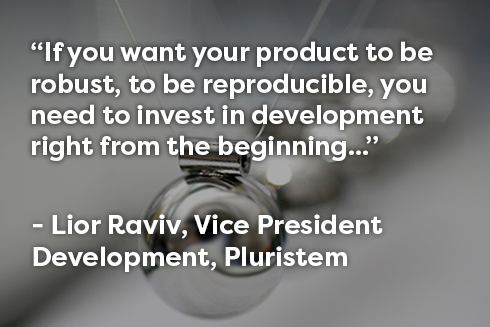Cell therapy process development: why and when?

Cell therapy process development and automation are critical to the future of cell therapy manufacturing - this was the topic of discussion during our exclusive interview with Lior Raviv, Vice President Development at Pluristem during Biotech Week Boston (Sept 18). The conversation for BWB TV was with editor of Cell Culture Dish Brandy Sargent. Watch the full interview or read the transcript below.
Brandy Sargent: I wanted to start by asking about the importance of process development and automation in the cell therapy field.
Lior Raviv: Generally, cell therapy is a new field. And for every new field, there needs to be new technologies, new approaches to manufacture the product. Cell therapy, if you think about it today, is purely manual, kind of more an art than a process. People can do it, other people do it and it won't be the same. So if you want your product to be robust, to be reproducible, you need to invest in development right from the beginning to be sure that you eliminate the human factor out of your manufacturing. This will give rise to more quality products coming onto the market with less investment in manufacturing, in costs of goods during production.
BS: And that brings up a good question. So when is the best time to really invest in process development?
LR: Actually we learned that the best time to do it is right from the beginning or whenever you understand that you need to do it. Technology will have imprints and fingerprints on your product, so if you think about industrialization, you will see that you need pumps, you need valves, you need this stuff in your process. And these will affect your product, so even if you start very early and work with small scales, you can actually add a pump into your process, even if it's not needed, but then you will get the fingerprint of the technology on your product.
RELATED ARTICLE: What is cell therapy?
So then you can learn how it's affecting your product, how it changes its characterization and you can adjust. So if you start very, very early outside your process, learning how these conditions will affect your product, it will be the best way, but the minute you understand and you want to go to development and automation, you just need to do it.
BS: Right, and in terms of 3D production, I wanted to find out how it's different and then also what ability it has to influence the industry?
LR: Pluristem is a cell therapy company, but it originated as a technology company with bioreactors that can support stem cell growth. The difference in this bioreactor was that the architecture the cells are growing in is 3D, so if you think about cell therapy dish, it's a 2D. But when you use 3D scaffolds, you actually create an organ-like environment, so cells are growing on the scaffold, they have the ability to secrete ECM components, extracellular matrix components, in between the fibers of the scaffold, and creating a small organ under a controlled environment inside your bioreactor.
So this growth environment is better for the cells and actually, when we started doing the experiments around 2006 when deciding which platform we would use, we tested the same batch growing on cell factors, so 2D compared to the 3D, and we saw tremendous changes in the cell's secretion, the cell's quality. This is why we chose, back then, to go to 3D.
I see now new technology emerging. Like gel scaffolds and other types of very, very smart scaffold that are 3D. This will give rise to a new level of products that are more prepared to be injected back into the body and more capable of growing because it's the same conditions as the cells originated from.
RELATED ARTICLE: Cell and Gene Therapies: Viral and Non-Viral Vector Manufacturing - WHITEPAPER
